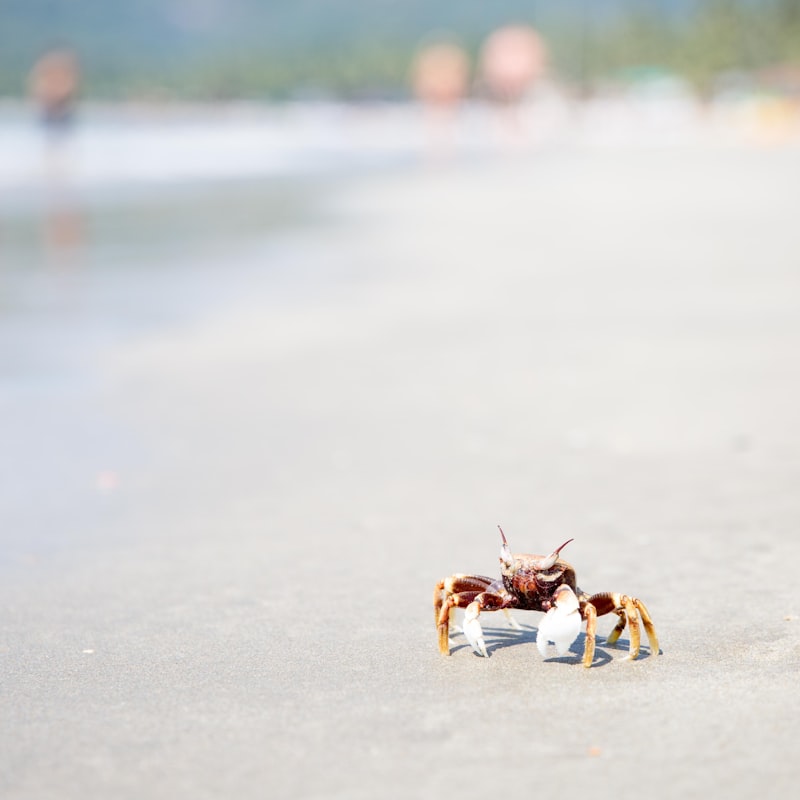Ever wondered how crustaceans, those fascinating creatures like crabs and lobsters, manage their growth and behavior? It all boils down to hormonal regulation, a complex but crucial process that governs their biological activities. In the world of crustaceans, hormones act as messengers, orchestrating various functions like molting, growth, reproduction, and even social interactions.
Molting, a pivotal part of a crustacean’s life, is intricately tied to hormonal changes. Before a crab or lobster can grow larger, it must shed its old exoskeleton through molting. This process is triggered by hormones that signal the body to absorb calcium carbonate from the old shell and begin secreting a new, soft one underneath. Imagine it like shedding old clothes to make way for a new, larger outfit – except crustaceans do this to accommodate their increasing size.
Beyond molting, hormones in crustaceans also influence their reproductive cycles. For instance, female crustaceans produce specific hormones that regulate the maturation of their eggs, ensuring they are released at the right time for fertilization. Similarly, male crustaceans have hormones that control the production and release of sperm.
Interestingly, hormones don’t just govern physical changes but also behavioral ones. Take aggression among crustaceans, for instance. Hormones play a role in dictating territorial behaviors and dominance hierarchies within their communities. This ensures that the strongest and most dominant individuals secure the best resources, such as prime feeding grounds or mates.
In essence, hormonal regulation in crustaceans is a finely tuned mechanism that integrates physiological processes with environmental cues. It’s a dynamic system where hormones act as the conductors of a biological orchestra, coordinating everything from growth spurts to reproductive cycles and social dynamics. Understanding these hormonal mechanisms not only sheds light on the fascinating lives of crustaceans but also provides insights into broader biological principles that apply across species.
Unlocking the Secrets: Hormonal Pathways in Crustaceans Revealed
Have you ever wondered how crustaceans, those fascinating creatures of the sea, navigate their complex hormonal pathways? These marine organisms, ranging from crabs to lobsters, hold a myriad of secrets beneath their shells, especially when it comes to their hormonal regulation.
In the world of crustaceans, hormones play a crucial role, much like they do in humans and other animals. These tiny chemical messengers control various physiological processes, including growth, reproduction, and molting. One of the key hormones at play is ecdysone, responsible for initiating the molting process—a critical phase where crustaceans shed their old exoskeleton to make way for new growth.
Researchers have delved deep into understanding how these hormonal pathways work. Through meticulous studies, they’ve uncovered that crustaceans produce ecdysone in specialized glands, triggering a cascade of events that culminate in molting. This process is not just a routine shedding; it’s a carefully orchestrated dance of hormones and enzymes, ensuring that the crustacean can grow and adapt to its environment effectively.
Moreover, crustaceans also rely on other hormones like androgens and estrogens, albeit in different forms compared to mammals. These hormones influence reproduction and secondary sexual characteristics among crustaceans, playing a pivotal role in their lifecycle and population dynamics.

Imagine the marvel of nature’s design—the intricate balance of hormones dictating when a crustacean grows, reproduces, or molts. It’s akin to a master painter meticulously adding layers of detail to a canvas, each hormone serving as a brushstroke that contributes to the masterpiece of crustacean biology.
From Molting to Maturation: The Role of Hormones in Crustacean Growth
During molting, a crucial phase in their life cycle, crustaceans shed their exoskeleton to accommodate growth. This process, controlled by hormones like ecdysteroids and juvenile hormones, initiates a cascade of physiological changes. Ecdysteroids, akin to crustacean “molting hormones,” prompt the secretion of enzymes that dissolve the old exoskeleton, allowing for expansion and the formation of a new, larger shell.

Juvenile hormones, on the other hand, play a pivotal role in coordinating molting cycles and ensuring proper development between molts. They regulate the timing and frequency of molts, ensuring that each molt leads to appropriate growth and size increase.
Beyond molting, hormones continue to influence crustacean development into adulthood. Growth is not just about getting bigger but also about maturing sexually and functionally. Hormones like androgens and estrogens contribute to sexual differentiation and reproductive maturation, ensuring that crustaceans are ready to reproduce when conditions are favorable.
Understanding these hormonal mechanisms is crucial not only for biological research but also for aquaculture and environmental conservation efforts. By studying how hormones influence growth and maturation in crustaceans, scientists can better manage and sustain crustacean populations in the wild and in aquaculture settings.
Hormones play a multifaceted role in the growth and development of crustaceans, from facilitating molting cycles to orchestrating reproductive maturation. Their intricate interplay ensures that these creatures grow and thrive in diverse aquatic environments worldwide.
Crustacean Metamorphosis: How Hormones Drive Transformation
Ever wondered how a tiny larva morphs into a formidable crustacean? It’s all about hormones orchestrating a spectacular transformation. Let’s dive into the fascinating world of crustacean metamorphosis and unravel the role of these powerful chemical messengers.
Crustaceans, like shrimp and crabs, undergo a dramatic change during their lifecycle, transitioning from larval stages to adulthood. This process, known as metamorphosis, is crucial for their survival and adaptation in various aquatic environments.
At the heart of this transformation are hormones. These biochemical signals act like conductors in an orchestra, coordinating complex changes in the crustacean’s body. One such hormone is ecdysone, responsible for triggering molting—the shedding of the old exoskeleton to allow growth. Think of it as shedding old clothes to make way for new, bigger ones.
But metamorphosis goes beyond mere growth. It involves profound structural and physiological changes. Limbs reshape, organs reorganize, and behaviors adapt to new roles in the ecosystem. This metamorphic journey is not just a physical change but a strategic adaptation honed by millions of years of evolution.
Interestingly, hormones don’t just initiate change; they regulate its timing and intensity. This precise control ensures that metamorphosis occurs when conditions are optimal, minimizing risk and maximizing survival chances for the crustacean.
Survival Strategies: Hormonal Adaptations in Crustaceans
Ever wondered how crustaceans like crabs and lobsters manage to thrive in diverse aquatic environments? The secret lies in their incredible hormonal adaptations. These creatures have evolved fascinating strategies to survive and thrive, navigating everything from changing water temperatures to predation threats.
One of the most remarkable adaptations is their ability to regulate growth and molting through hormones. Crustaceans undergo molting periodically, shedding their exoskeleton to grow larger. This process is tightly controlled by hormones like ecdysteroids, which initiate and regulate the molting cycle. It’s a carefully orchestrated dance of hormone signals that ensures the timing is just right, allowing them to grow while minimizing vulnerability during the molting process.
Another critical adaptation involves osmoregulation, particularly important for species living in varying salinity levels. Crustaceans maintain internal salt concentrations through hormonal mechanisms, adjusting their ion transport processes depending on whether they are in freshwater or saltwater environments. This ability helps them survive in habitats ranging from estuaries to deep ocean trenches, where salinity can fluctuate dramatically.
Furthermore, crustaceans utilize hormones to respond to environmental stressors. For instance, during periods of low oxygen or high temperatures, they release stress hormones like corticosteroids. These hormones trigger physiological changes that enhance their chances of survival, such as increased ventilation rates or altered metabolic processes to cope with oxygen depletion.
In essence, crustaceans exemplify nature’s mastery of survival through hormonal adaptations. These tiny creatures navigate complex environments with an arsenal of biological tools honed by millions of years of evolution. By understanding their hormonal strategies, scientists gain insights not only into crustacean biology but also into broader principles of adaptation and resilience in the natural world.
Frequently Asked Questions
What are the key hormones involved in regulating crustacean physiology?
This FAQ provides a concise overview of the key hormones that regulate crustacean physiology. It focuses on the main hormones such as ecdysteroids, methyl farnesoate, and crustacean hyperglycemic hormone (CHH), detailing their roles in growth, molting, reproduction, and metabolism.
What are the similarities and differences in hormonal regulation between crustaceans and other arthropods?
This FAQ explores the similarities and differences in hormonal regulation between crustaceans and other arthropods. It provides a concise comparison of how hormones control physiological processes such as molting and reproduction in these diverse groups of invertebrates.
What role do eyestalks play in hormonal control in crustaceans?
Eyestalks in crustaceans play a crucial role in hormonal control by housing neurosecretory cells that produce and release hormones. These hormones regulate various physiological processes such as molting, reproduction, and metabolism throughout the crustacean’s lifecycle.
How does environmental stress affect hormonal balance in crustaceans?
Learn how environmental stress impacts hormonal balance in crustaceans, affecting their growth, reproduction, and overall health. Understand the critical role of hormones in crustaceans’ physiological responses to environmental changes.
How do crustacean hormones influence molting and growth?
Learn how crustacean hormones regulate molting and growth processes. Understand the pivotal role these hormones play in initiating and coordinating the shedding of old exoskeletons and stimulating growth phases in crustaceans.


